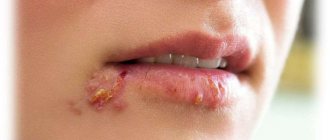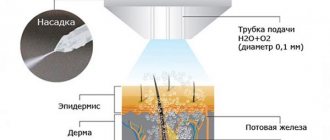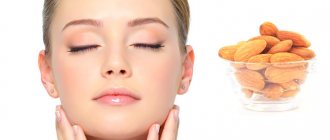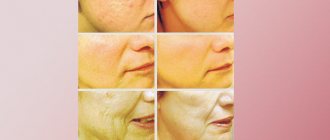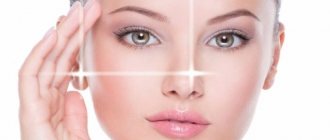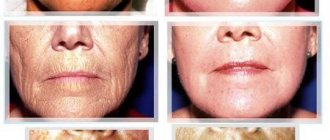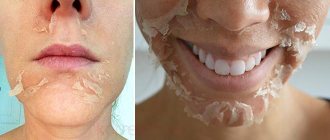Purpose of chemical peels – improve the condition of the skin of the face or body through the controlled destruction of target layers of the skin with chemicals. As a result, dead skin particles are sloughed off, and new, healthier tissue is formed in their place. Restored skin is generally characterized by greater smoothness and less wrinkles and pigmentation.
In aesthetic dermatology, chemical peels are a common procedure due to their effectiveness in eliminating signs of aging such as wrinkles, sallow complexion, pigmentation disorders and sagging skin. A cosmetologist needs to understand how superficial, medium and deep chemical peels work, what precautions need to be taken and what contraindications to take into account in order to choose a safe and effective procedure for each patient.
Classification of chemical peels: superficial, medium and deep
Chemical peels are classified according to the depth of penetration and the damage to the skin they cause:
- superficial peels penetrate the epidermis to the basal layer;
- Medium peels penetrate to the papillary dermis;
- deep peels penetrate to the level of the reticular dermis.
The peeling solution used for the procedure does not necessarily determine the depth of the peel - it depends on several factors, including:
- solution concentration;
- pH;
- presence or absence of free acid;
- exposure duration;
- skin conditions;
- application method.
For example, a 70% glycolic acid solution can act as a superficial peel (applied for 5 minutes) or a medium peel (applied for 15 minutes). Trichloroacetic acid, depending on the concentration, can be used as a superficial, medium or deep peel.
A separate stage in the evolution of chemical peels was their combined use - the sequential application of various substances, providing a synergistic effect and a lower side effect profile.
Kinds
Removal of the epidermis can be done in several ways. Depending on the exfoliation mechanism, there are three types of medium peeling:
- Mechanical.
- Physical.
- Chemical.
Cells are exfoliated, evaporated or coagulated, which is obtained due to heterogeneous effects. Depending on its depth, peeling can be mid-superficial or mid-deep. The first helps with age spots, the effects of acne, scars, and the second is used to correct age-related changes on the skin of the face.
Mechanical
Removal of the surface layer of skin mechanically can be achieved through grinding (dermabrasion). It is performed with a special apparatus with a rotating abrasive nozzle or a jet of microcrystals. Peeling is quite traumatic, but it allows you to smooth out more pronounced irregularities in the epithelium.
Physical
Physical peeling is also carried out using hardware methods. For this purpose, laser radiation is used - a concentrated beam of high power light. There are two types of this procedure:
- Fractional photothermolysis.
- Laser resurfacing.
The first is characterized by irradiation of individual areas of the skin in a mesh projection, which reduces trauma and speeds up recovery. And grinding is performed over the entire surface of the skin, but in this case the effect is more pronounced. Several types of lasers are used for procedures: neodymium, erbium, carbon dioxide.
Mechanical and physical peelings are hardware procedures that require appropriate equipment.
Chemical
The most popular peeling is chemical. Various acids are used as active substances for exfoliation:
- Trichloroacetic (TCA).
- Fruit (wine, apple, lemon).
- Dairy.
- Koyevaya.
- Retinoic.
- Almond.
- Glycolic.
- Salicylic.
- Ascorbic acid.
In this case, not aqueous solutions are used, but gel forms, which allow better control of the depth of penetration of the acid. Chemical peeling, in addition to its main effects, has antiseptic and anti-inflammatory properties.
Preparing the skin for medium and deep chemical peels
Before any chemical peel, including medium or deep, the patient's skin must be properly prepared. The purpose of this preparation is to reduce the likelihood of adverse events such as post-inflammatory hyperpigmentation, provide more effective rejuvenation, and identify potential problems associated with products used during or after the peel procedure. For this use:
- a cleanser or moisturizer with a low concentration of alpha hydroxy acids;
- retinol/isotretinoin and/or a skin lightening agent, for example, hydroquinone, kojic acid, etc.;
- sunscreens that suppress the excitability of melanocytes.
The duration of the skin preparation program is at least 2 weeks before the peeling procedure.
Indications and contraindications
Chemical peeling is effective for the following problems:
- the presence of wrinkles on the face;
- dysfunction of the sebaceous glands;
- excessive dryness of the skin;
- the presence of dark circles under the eyes or age spots.
Peeling stimulates elastin production. It helps eliminate acne.
The cosmetic procedure should be avoided if the following contraindications exist:
- allergic reaction to components of folk remedies;
- presence of warts on the face;
- herpes;
- dermatitis;
- eczema;
- increased body temperature;
- severe heart disease;
- presence of scratches or cuts on the face;
- high blood pressure.
Medium peelings: indications, features, results
Medium peels are indicated if:
- fine lines and wrinkles associated with photoaging;
- pigmentation disorders;
- superficial atrophic scars.
Traditionally, medium peels use trichloroacetic acid (TCA) in a concentration of 40–60%. This approach is quite effective, but is associated with an increased risk of complications such as scarring and pigmentation. Similar results with less risk can be achieved by using TCA 35% solution in combination with Jessner peel, glycolic acid 70% or carbon dioxide solids.
Before and after Easy TCA peel, Blending Bleaching Cream and DHEA. Photo: SkinTech and AestheticSource
Jessner's solution and trichloroacetic acid 35%
Jessner's solution consists of 14 g salicylic acid, 14 g lactic acid and 14 g resorcinol, diluted with ethanol to 100 ml. Before applying this medium peel, the skin is cleansed and thoroughly wiped with acetone to remove sweat and sebum. In the case of hypertrophic actinic keratosis, curettage can also be performed at this stage.
Peeling is applied to cleansed and oil-free skin using a cotton applicator. After reaching the end point of the procedure - the appearance of white frost and uniform redness of the skin - a cold compress can be applied to the treated area to soothe the skin and relieve discomfort.
Jessner peel provides a keratolytic effect and increases the permeability of the epidermal skin barrier, due to which the TCA solution penetrates the skin more evenly and quickly.
After removing the Jessner peel, an anesthetic such as EMLA or LMX may be applied to the skin to make the TCA peel more comfortable for the patient.
After removal of the topical anesthetic, TCA 35% solution is applied to dry skin. To do this, use a cotton swab or a small gauze pad. After reaching the end point - the appearance of a uniform white frost against the background of erythema - a cold compress is applied to the treated area in order to reduce the burning sensation that the patient feels for about 10 minutes after applying the composition. Then an occlusive ointment, such as Vaseline or Aquaphor, is applied to the skin, which eliminates dryness after peeling.
Before and after Easy Phytic treatment and Purifying Cream. Photo: SkinTech and AestheticSource
Glycolic acid 70% and trichloroacetic acid 35%
This approach provides the same results as the Jessner peel technique, but uses glycolic acid as the initial superficial peel. Glycolic acid has a keratinolytic effect and enhances the penetration of TCA by 35%. As a rule, it is applied for 2 minutes, after which it is neutralized with a bicarbonate solution or cold water. Glycolic acid is not suitable for inflamed or dry skin.
Solid carbon dioxide and TCA 35%
This technique involves using solid carbon dioxide coated with acetone. The substance is applied to the skin to damage the epidermis. The depth of epidermal damage, penetration and effect of the TCA solution depends on the time of exposure to CO2. Thus, areas that require deep peeling (for example, deep wrinkles, scars, thick actinic keratoses) can be exposed to the composition for a longer period of time.
The advantage of this technique is an excellent aesthetic result, but it must be remembered that the results largely depend on the doctor performing the procedure and the application technique.
How to do it at home?
For self-performing, superficial peeling is better suited, but if desired, you can also do a medium peel. This requires much more careful preparation, compliance with all rules and conditions. The peeling composition can be purchased ready-made or created at home. In the latter case, it is recommended to use the following ingredients:
- Calcium chloride solution and milk.
- Camphor, ammonia and boric alcohols, hydrogen peroxide, glycerin.
- Bodyagi powder with hydrogen peroxide.
During the cooking process, it is necessary to observe the correct proportion and sequence of actions. A multicomponent mixture can be prepared according to the following recipe:
- Glycerin, camphor alcohol and hydrogen peroxide (30 ml each).
- Ammonia and boric alcohol (10 ml each).
- Calcium chloride solution 10% (1 ampoule).
- Baby soap.
First, camphor alcohol, glycerin, ammonia, boric alcohol and hydrogen peroxide are mixed sequentially in a container. Rub a small bar of baby soap into another container and combine it with the previously obtained solution until a creamy consistency is obtained. The mixture is applied to the face, left for 15 minutes, and then neutralized with calcium chloride.
From ready-made products, trichloroacetic acid is used, which is only diluted to a concentration of 15–20%. It is applied to the face using cotton swabs in one layer, left for 2-4 minutes, and then neutralized with a soda solution (accompanied by hissing). Residues are washed off with plenty of water.
At the end of the mid-peel, the face is soothed with a mask and moisturized with a daily product. The home treatment also requires the use of triclosan cream or three antibiotics (bacitracin, neomycin, polymyxin B).
Mechanism of action of medium peels
The main active ingredient of medium peels – TCA – leads to protein denaturation. Trichloroacetic acid is water soluble and does not easily penetrate into sebum-rich skin. Therefore, the task of preliminary skin preparation and surface peeling, which is applied before TSA, is to thin and increase the permeability of the stratum corneum, as well as remove fat from the skin surface.
This ensures deeper and more uniform penetration, as well as uniform protein denaturation.
Technology of the technique
You should not perform such a procedure yourself at home, as there is a risk of significant damage to important, deep layers of the epidermis. The procedure takes place in the following order:
- Cleansing the skin of decorative cosmetics and other contaminants accumulated on it using products with a pH level of 4.5 to 5.5.
- Degreasing the skin surface.
- Treatment of necessary areas of the face with anesthetic drugs.
- Application of an acidic composition to the skin, followed by exposure to a laser or ultrasound device in accordance with established directions of movements.
- Apply 2 and 3 layers of acidic product at intervals of 5 minutes.
- Removal of peeling residues with a specially prepared neutralizer.
- Applying a mask to the skin with a pronounced calming and anti-inflammatory effect.
- Apply a high-quality nourishing or moisturizing cream with light massage movements.
Most cosmetologists believe that for heavy smokers, the results of peeling will be negative and unexpressed due to the negative effect of nicotine accumulated in the body. They recommend completely quitting smoking 2 weeks before and after the procedure.
Results of using medium peels
Immediately after a midline chemical peel, the skin may feel swollen and tight. Some practitioners recommend regularly (several times a day) applying occlusive ointments to the skin after the procedure, as they shorten the recovery period and reduce skin redness after medium peels.
The epidermis, located above the level of chemical damage, separates from the underlying skin from about the third day, resulting in a serous exudate and crust appearing on the skin. The skin begins to peel off from the perioral area, this process ends on the forehead.
Patients are advised not to pick off the peeling epidermis, as such actions can lead to scarring. In this case, it is allowed to cut off the exfoliated skin with scissors. 5 days after the procedure, you can apply a moisturizer to the skin; the exfoliation process itself can take up to 10 days.
After the epidermal layer is peeled off, patients typically notice that the new skin looks more radiant and its color is more even; the severity of pigmentation and other skin imperfections is noticeably reduced, fine lines and wrinkles are smoothed out. During the process of dermal remodeling, neocollagenesis starts after about 6 weeks, which helps improve skin quality.
Depending on the degree of photodamage and aging, your doctor may recommend repeated peeling procedures for more effective rejuvenation. 3 weeks after the initial peel, the skin can be prepared again for a subsequent procedure.
3 weeks after the first medium peeling procedure, the skin can be prepared again for the next procedure.
Before and after the procedure Easy Phytic, DHEA-Phyto and Re-Nutriv ACE Lipoic Complex. Photo: SkinTech and AestheticSource
Chemical peeling
Chemical peeling
(from English to peel - to cleanse, remove the skin) can rightfully be called one of the most popular cosmetic procedures.
The main task of any chemical peel is to exfoliate the surface layer of skin cells in order to activate/start renewal processes. During the procedure, solutions of acids - chemical exfoliants - .
The effectiveness of the use of acids is due to their plasticizing effect: they break down the protein bonds between epidermal cells and thus promote their desquamation. In addition, chemical exposure stimulates reparative processes, which leads to the activation of fibroblasts and an increase in the synthesis of collagen and other components of the dermis. The composition and therapeutic capabilities of modern chemical exfoliants have been significantly expanded , since most drugs are multicomponent and contain several active, functionally complementary acids, as well as vitamins and various extracts. This means that the same peeling can be equally effective for treating acne, eliminating hyperpigmentation or dry skin, and for the purpose of rejuvenation, etc.
Types of chemical peeling
Depending on the intensity of penetration of chemical exfoliants into the epidermis, peeling procedures allow for therapeutic “aggression” at three levels: superficial - to the depth of several layers of keratinized cells, middle - to the entire thickness of the stratum corneum, and deep - to the depth of the entire layer of the epidermis - to the border basal layer of membrane and papillary dermis.
- Superficial peeling is the most gentle; it does not lead to serious disorders of the epidermal system, and therefore does not require subsequent rehabilitation. This peeling can be performed on any skin type. True, the effectiveness of this procedure depends on a whole range of factors: the chemical agent itself and its characteristics (type of acid, concentration, pH), the thickness of the patient’s stratum corneum, exposure time and individual skin sensitivity. Of course, the starting point is the skin type and the nature of cosmetic defects, which must be eliminated with the help of chemical exfoliants.
- Medium peeling - usually performed in mature and old age or in patients in the treatment of acne (blackheads) and post-acne, scars and scars, as well as stretch marks. The penetration of the constituent ingredients of the peeling solution occurs deeper and their concentration is higher than with superficial peeling. The range of tasks solved by this peeling is much wider. The medium peeling procedure allows you to normalize the function of the sebaceous glands, smooth out already formed wrinkles and age spots that have appeared not only on the face, but also on the neck and arms. Medium peeling requires pre-peel preparation of the skin. The recovery period after the procedure can range from 5 days to 10 days. During this period, proper skin care is necessary.
- Deep peeling is the most aggressive and often causes intoxication of the entire body. This procedure uses acids and other active ingredients that penetrate deeply into the skin. The procedure is painful and is performed under general anesthesia in a hospital setting. After it is performed, the patient experiences significant discomfort. The recovery period can take from several weeks to 6 months.
With the introduction of modern laser technologies, the need for deep chemical peeling has completely disappeared.
An alternative to it currently consists of laser peels and laser skin resurfacing. Such laser procedures are several times more effective, and at the same time are much less traumatic, do not require anesthesia, and do not cause intoxication. And most importantly, they are very controlled in terms of effectiveness and rehabilitation time - no more than 1 - 8 days. In our clinic, laser peeling and laser skin resurfacing procedures are carried out using a modern professional ablative erbium laser of the latest generation, Fotona SP Dynamis .
- Retinoic (yellow) peeling should be considered separately, since its mechanism of action is fundamentally different from other chemical peels. Retinol and its derivatives in the peeling composition do not lyse intercellular proteins and do not destroy skin cells, but primarily have a stimulating effect. The protocol for retinoic peeling can be either superficial or medium.
Before and after peeling
It is important to remember that chemical exfoliants - acids - are, first of all, chemically active agents, therefore, upon contact with the skin, they can cause neurogenic inflammation - as a response to irritation of nerve endings in the epidermis, and inflammation/burn - as a reaction to irritation of sensitive skin fibers by a caustic substance .
Therefore, given the wide variety of modern chemical peels, the high activity of their components and wide functionality, we recommend that such procedures be carried out under the supervision of specialists!
The safety of using chemical peels in our clinic is guaranteed by highly qualified specialists and compliance with a standardized protocol for the peeling procedure, which includes four mandatory stages: pre-peel skin preparation, peeling itself, acid neutralization and post-peel care.
The doctors at our clinic have more than 20 types of professional chemical peels in their arsenal. The table shows the most popular and effective:
| Peeling | Indications | |
| HOLY LAND (Israel) | ALPHA-BETA with Retinol Professional Peeling (ABR) | Lifting. Acne. Post-acne. Scarring. Folliculitis. Ingrown hair. Lymphatic drainage. Alignment of skin color and texture. (Autumn, winter, spring). Surface. Fine-plate peeling for 2-3 days, complete rehabilitation for 3-4 days. |
| ALPHA-BETA with Retinol DEEP CLEAN PEEL (ABR) | Atraumatic cleaning. Acne, post-acne. Lifting. Alignment of skin color and texture. (Autumn, winter, spring). Superficial-medium. Fine- and medium-plate peeling for 2-3 days, complete rehabilitation for 4-5 days. | |
| ALPHA COMPLEX Rapid Exfoliator | Atraumatic cleaning. Stimulating massage. Preparation for other peels. Seborrheic dermatitis of the scalp. Peeling for home use for acne and post-acne. Procedures during pregnancy. (All season). Surface. Virtually no peeling. There is no rehabilitation. | |
| DMK (Danne Montague-King) (USA) | Quick Peel | Lifting. Alignment of color and relief. Improving microcirculation. Immunomodeling effect. Improving metabolic processes. (All season). Surface. Surface. No peeling. There is no rehabilitation. |
| Mediderma (Spain) | MANDELAC PEEL M | Acne of mild to moderate severity. Folliculitis. Rosacea. Depigmenting action. (All season). Superficial-medium. Fine-plate peeling for 2-3 days, complete rehabilitation for 4-6 days. |
| MANDELAC exfoliating gel | Dermal melasma. Photo- and bioaging. Acne of mild to moderate severity. Suitable for normal sensitive skin. (All season). Surface. Virtually no peeling. There is no rehabilitation. | |
| MANDELAC PEEL L | Hyperpigmentation. Melasma. Fading skin. Preparation for laser resurfacing, medium and deep chemical peels. Used for skin tolerant to mandelic acid. (All season). Superficial-medium. Fine-plate peeling for 2-3 days, complete rehabilitation for 4-6 days. | |
| SALIPEEL S | Acne (I-IV degree of severity). Seborrheic dermatitis. Rosacea. Folliculitis. (Autumn winter). Median. Medium- and large-plate peeling on days 3-4. Complete rehabilitation 6-8 days. | |
| SALIPEEL SP | Folliculitis. Acne, post-acne. Rosacea. Psoriasis. (Autumn winter). Median. Medium- and large-plate peeling on days 3-4. Complete rehabilitation 6-8 days. | |
| MELASPEEL J2 (Jessner peel) | Acne, post-acne. Photoaging. Chronoaging. Striae. (Autumn winter). Median. Large-plate peeling on day 3-4. Complete rehabilitation 8-10 days. | |
| UltraCeuticals (Australia) | Mandelic Acid Peel | Suitable for the eye area. Antibacterial action. Depigmenting action. (All season). Surface. Virtually no peeling. There is no rehabilitation. |
| Lacticpeels | Intense hydration. Stimulation of microcirculation. Strengthening metabolic processes. Stimulation of collagen and elastin synthesis. Restoration of the skin's protective barrier, intensive nutrition. (All season). Surface. Virtually no peeling. There is no rehabilitation. | |
| Cimel (Spain) | Retinoic peeling | Signs of skin aging of various etiologies. Hyperpigmentation, chloasma. Hyperkeratosis, follicular hyperkeratosis, keratomas, ichthyosis. Problem skin, seborrhea, acne. Restores extracellular structures of the dermis. Pronounced whitening effect. (Autumn, winter, early spring). Superficial-medium (effect as from the median). Fine- and medium-plate peeling for 2-3 days, complete rehabilitation for 5-7 days. |
| Christina (Israel) | Rose de Mer (Coral peeling) | Hyperpigmentation. Acne, post-acne (infiltrates, scars, stagnant spots, etc.). Enlarged pores. Scarring. Stretch marks. Hyperkeratosis. Premature skin aging. (All season). It is used according to two protocols: both superficial and superficial-median. Medium- and large-plate peeling on days 3-4. Complete rehabilitation 6-8 days. |
| ME LINE (Lab. Innoesthetics, Spain | ME LINE Intimate | Therapeutic peeling for the correction of hyperpigmentation of intimate areas. (All season). Superficial-medium - a pronounced effect of remodeling the underlying layers of the skin with minimal trauma to its surface!!! No peeling. No rehabilitation. |
| ENERPEEL (General Topics, Italy) | ENERPEEL SA 30% (salicylic peeling) | Non-inflammatory and inflammatory forms of acne. Seborrhea. Actinic hyperkeratosis. Photo- and chronoaging. (Autumn, winter, early spring). Superficial-medium (effect as from the median). Fine-plate peeling is possible for 2-3 days, complete rehabilitation is 1-3 days. |
| ENERPEEL Neck (neck, décolleté, elbows) | Hyperpigmentation. Actinic keratosis. Photo- and chronoaging. (All season). Superficial-medium – a pronounced effect of remodeling the underlying layers of the skin with minimal trauma to its surface!!! No peeling. No rehabilitation. | |
| ENERPEEL Hands (back of hands) | Hyperpigmentation. Actinic keratosis. Photo- and chronoaging. (All season). Superficial-medium - a pronounced effect of remodeling the underlying layers of the skin with minimal trauma to its surface!!! No peeling. No rehabilitation. | |
The chemical peeling procedure is carried out exclusively by qualified dermatocosmetologists using certified products. As a rule, to obtain optimal results, such procedures are carried out in courses.
IMPORTANT!!!
Only an experienced doctor can determine what type of peeling a patient needs, based on the condition of the skin, the degree of the defect that needs correction, the absence of contraindications to a specific type of procedure and the season of the year.
Before and after results
- Almond peeling “Mediderma”
3200 rub. - Salicylic peeling "Mediderma"
3900 rub.
- Azelaine peeling "Mediderma"
3100 rub.
- Hycolic + salicylic combined peeling “Mediderma”
4300 RUR
- Glycolic peeling 50-70% “Medexfol”
3100 rub.
- AHA peeling “Holy Land” + care
3800 rub.
- ABR- peeling, “Holy Land” face + care
3900 rub.
- ABR- peeling, back “Holy Land” + care
5800 rub.
- AHA + ABR combined peeling, face “Holy Land”
4500 rub.
- AHA + ABR combined peeling, back “Holy Land”
6800 rub.
- Trichloroacetic peeling "Medexfol"
6300 rub.
- Coral peeling, face “Christina”
5200 rub.
- Coral back peeling “Christina”
7200 rub.
- Retinol peeling ICP “Martinex”
8700 rub.
- PRX-T33 peeling
4200 rub.
- PRX-T33 (face + neck + décolleté)
7500 rub.
- Enzyme peeling Lactolan “Holy Land” + care
3600 rub.
- Enzyme peeling “Danne” + care
4700 rub.
- Depigmenting peeling M.E.Line for intimate areas + home care, brightening.
14200 rub.
- Depigmenting peeling Enerpeel NECK
3100 rub.
- Jessner Peel
3800 rub.
- Purges
- Manual cleaning “Holy Land”
4200 rub.
- Manual cleaning "Danne"
5300 rub.
- Manual cleaning “Christina”
5200 rub.
- Combined manual cleaning “Enerpeel SA”
3200 rub.
- Combined cleaning “Holy Land”
4500 rub.
- Combined cleaning “Danne”
5700 rub.
- Millium removal
350 rub.
Deep peelings: mechanism of action, implementation, results
TCA is also used as a deep peeling in concentrations above 50%, but the frequency of complications in such cases makes phenol peeling a more attractive alternative.
Mechanism of action of phenol peeling
Like TCA, phenol penetrates the skin and leads to the denaturation and coagulation of proteins at a certain depth in the dermis. Moreover, unlike TCA, phenol penetrates the skin quickly, reaching the reticular dermis layer. Therefore, phenol peels are fast, but it is impossible to control the depth of their penetration as effectively as in the case of TCA.
Phenol deep peels are fast, but it is impossible to control the depth of their penetration as effectively as in the case of TCA.
When using any phenol peeling composition, the result is protein coagulation in the reticular dermis, therefore the indications for the use of deep peels are:
- moderate to deep wrinkles;
- dyschromia;
- post-acne.
Due to epidermolysis, which also affects the papillary dermis, deep peels can achieve better results in eliminating wrinkles and pigmentation than medium peels, which penetrate only to the papillary dermis.
Before and 8 months after melanoma treatment with CosMedix Benefit Peel x3, Timeless Rx Peel x1 and Deep Sea Peel x1. Photo: Medico Beauty
The deep phenol peeling procedure is associated with more risks than the medium peel, because:
- the likelihood of scarring increases due to greater depth of dermal damage, prolonged healing, post-inflammatory hyperpigmentation and hypopigmentation;
- phenol enters the bloodstream and has cardiotoxic effects, thereby increasing the risk of heart failure.
The degree of risk depends on the volume of phenol. If the procedure is carried out on the entire face, the solution is applied alternately in zones. Cardiac monitoring in an appropriate clinical environment is strongly recommended when treating the entire face with phenol.
Phenol peels cause significant discomfort and are therefore sometimes performed under general anesthesia. At a minimum, the patient is sedated before, during, and after the procedure.
Before the procedure, the skin is cleansed and degreased in the same way as before medium peels.
The phenol solution is applied to the skin using folded gauze. After treating one area, the solution is washed off, then proceed to applying it to the next area. The end point of deep peeling is a gray-white frost, consisting mainly of coagulated protein; the disappearance of erythema in the frost area means that the peeling has penetrated deeper than the vascular loops of the papillary dermis.
How to do deep peeling
This procedure is performed in a hospital setting and using anesthesia. Deep peeling is a severe chemical burn followed by skin regeneration. It is designed to eliminate deep scars and wrinkles.
After a deep chemical peel, the rehabilitation period can last up to six to seven months. A positive result may last for several years.
Phenol is used for deep processing . The procedure is extremely dangerous and painful and requires highly qualified performers.
Due to the severity of the impact and the likelihood of side effects, deep chemical facial cleansing is used quite rarely. However, if the procedure is performed by experienced and skillful hands, then the effect will be simply excellent .
Stages of the procedure
The procedure for cleansing the skin using special substances consists of several main stages:
- Preparation. It is needed in order to properly prepare the skin for acid exposure and ensure maximum penetration of peeling agents. It is advisable to start preparing a couple of weeks before the procedure. A specialist will recommend good care products and preparations, based on your skin type and goals.
- Direct cleaning. In front of him, the cosmetologist will also determine the period of influence of the selected product. After this, the skin is treated, UV protection products are applied, and instructions are given regarding post-peeling care at home.
- Care after the procedure. Its primary task is to prevent possible complications and side effects, as well as to consolidate the results obtained. All remedies are prescribed by a specialist, the patient just has to follow all the instructions.
The cost of chemical peeling depends on the cosmetology center and region . But the average cost is set at:
- deep - about 15 thousand rubles;
- middle - about 8 thousand rubles;
- superficial - about 4 thousand rubles.
In order to find out the specific amount, it is better to contact representatives of cosmetic centers that provide this type of service.
Results of using deep phenol peels
The recovery period after deep phenol peeling is quite long. For the first 48 hours after the procedure, an occlusive waterproof bandage is applied to the face. At this stage, the skin needs careful care - applying thymol iodide several times a day for a week.
Interesting: Phenol peeling. Features of composition and application
During the first 7 days after the procedure, as a result of mobility of the perioral area, cracks may form in the treated area, so patients are advised to consume liquid food through a straw. Re-epithelialization is observed approximately on the ninth day after deep peeling; during this period, compresses with warm water and softening agents can be carefully applied. Erythematous and swollen new skin after very deep peels can be observed for up to four weeks.
The result of using phenol peels is a noticeable and long-term smoothing of facial wrinkles, elimination of pigmentation and improvement of skin texture.
Before and 10 months after acne treatment with CosMedix Purity Peel x5, Blueberry Jester x2, Timeless Peel x2 and Deep Sea Peel x1. Photo: Medico Beauty
Performance
It is better to carry out any of the medium peels in beauty salons or clinics, because they involve the removal of almost the entire epidermis, and this is a rather traumatic procedure. Thorough preparation is required before performing it. In order for medium peeling to show the greatest effectiveness and be safe, it is first recommended to do the following:
- Even out the thickness of the stratum corneum (superficial peeling, creams with fruit acids, retinoids).
- Prevent pigmentation (whitening, sunscreen).
- Reduce the risk of exacerbation of herpes (take antiviral drugs).
- Improve the tolerability of the procedure (hydration and antioxidants).
- Eliminate contraindications (examination by a doctor).
Having made advance preparations, they begin activities that precede the procedure itself. The facial skin is cleansed of decorative cosmetics and other contaminants, degreased and treated with a local anesthetic, the lip and eye area is lubricated with a rich cream. Next, a chemical substance (acid) is applied or applied using hardware methods.
The face is processed starting from the forehead and temples, then moving to the chin, cheeks, nose, and eyelids. Chemical peeling involves using an acid solution 3 times at 5-minute intervals. Residues are neutralized with a special agent. At the end of the procedure, a soothing mask is applied to the face and a moisturizing and nourishing cream is applied.
Medium peeling is a responsible procedure that must be entrusted to an experienced specialist.
Possible complications after medium and deep chemical peels
While medium chemical peels provide excellent results, there are a number of complications that can occur after using them. Careful patient selection, proper selection of peels, pre-treatment of the skin, and careful monitoring of treatment endpoints reduce the incidence of complications.
- Erythema after midline chemical peels is normal and should resolve within 3-4 weeks. In some cases, redness may persist longer, indicating contact sensitization pre-existing skin disease (rosacea/eczema) or spontaneous penetration of the peel deeper than expected.
- Scarring after midline chemical peels is rare, but may appear several months after the procedure. This complication can be identified by areas of intense and prolonged erythema and induration. In this case, early and appropriate treatment with topical steroids can give good results.
- Herpetic lesions in patients with a history of this disease are quite common. Therefore, it is necessary to carefully study the patient's medical history before the procedure and prescribe prophylactic antiviral therapy to patients at risk. Some practitioners prescribe antiviral medications to all patients who undergo chemical peels.
- Infections after midline chemical peels develop infrequently, and in this case their early identification during the recovery period is very important. Indicators of infection may be: more pronounced than expected, erythema, pustules, pain.
Careful patient selection, proper selection of peels, pre-treatment of the skin, and careful monitoring of treatment endpoints reduce the incidence of complications.
- Permanent hypopigmentation is a complication that most often occurs in people with dark skin types after deep peels. This phenomenon may be associated with other complications, such as infection during the recovery period.
- Post-inflammatory hyperpigmentation, like hypopigmentation, most often occurs after deep peels and in patients with pre-existing pigmentation disorders. This risk can be reduced by properly preparing the skin for the procedure and, if such a complication occurs, hydroquinone 4% is applied to the skin.
The doctor must promptly identify risk factors associated with complications and refuse to perform peels on patients in the following cases:
- smoking;
- poorly controlled diabetes;
- weakened immune system;
- recent skin lifting;
- laser skin resurfacing;
- history of recent or existing herpes simplex virus infections;
- history of hypertrophic and/or keloid scars.
Use of isotretinoin 6 to 12 months before peels is associated with an increased likelihood of scarring.
List of contraindications for use
Always honestly tell your cosmetologist about the presence of chronic diseases, seasonal exacerbations and a predisposition to allergic reactions in order to avoid or significantly reduce the number of side effects, as well as complications after performing the technique.
The main contraindications to medium peeling are:
- period of pregnancy and lactation;
- pathologies of the cardiovascular system;
- inflammatory processes on the skin surface;
- herpes virus, which is in the acute stage;
- a large number of ulcers and boils;
- intense tan on the skin;
- individual sensitivity to the active components of drugs and a tendency to allergies;
- eczema, psoriasis;
- period of the monthly cycle;
- menopause;
- acute respiratory and infectious diseases;
- oncological processes occurring in the body;
- mental disorders;
- diabetes;
- pathology of connective tissue, which forms the formation of scars at the site of damage to the epidermis;
- any damage to the integrity of the skin;
- long-term use of antibiotics and contraceptives.
Many beauty salons incorrectly classify the same type of peeling. For example, the Jessner method is indicated in price lists as a deep type of peeling, although in fact it refers to a superficial-middle procedure, and the phenolic method is offered as a middle type of manipulation, but it is able to penetrate to the deepest - the basal layer of the dermis.
Peeling procedure for problem skin, before and after photos



